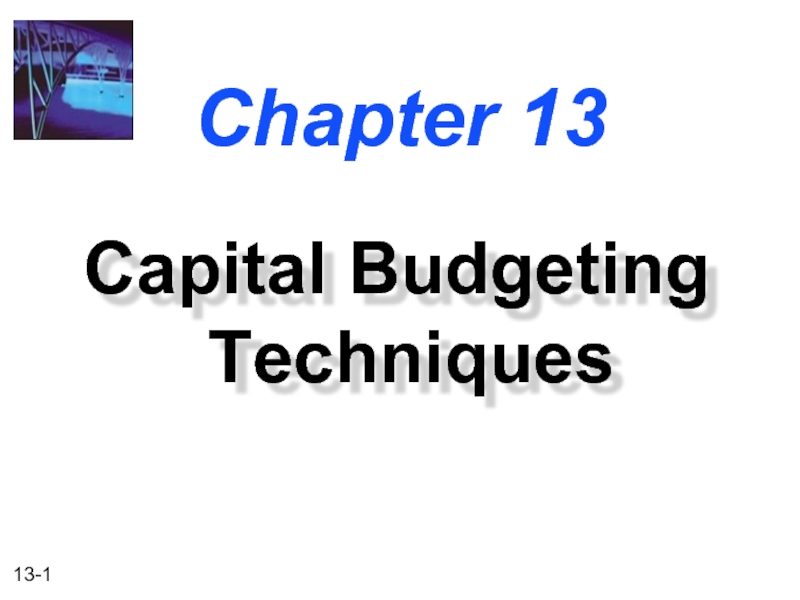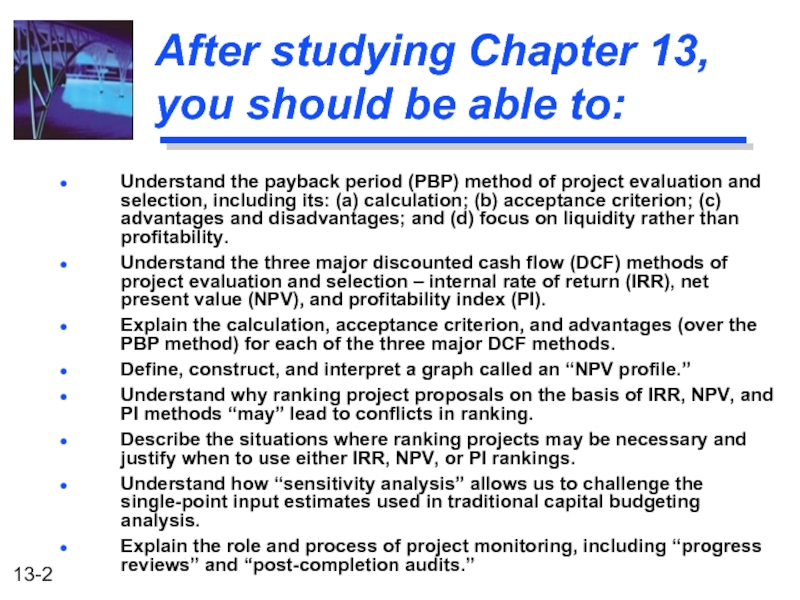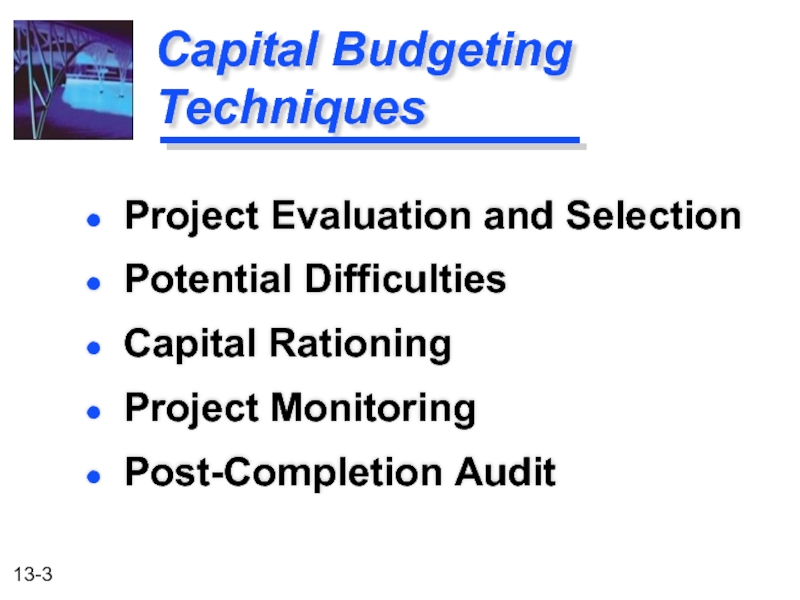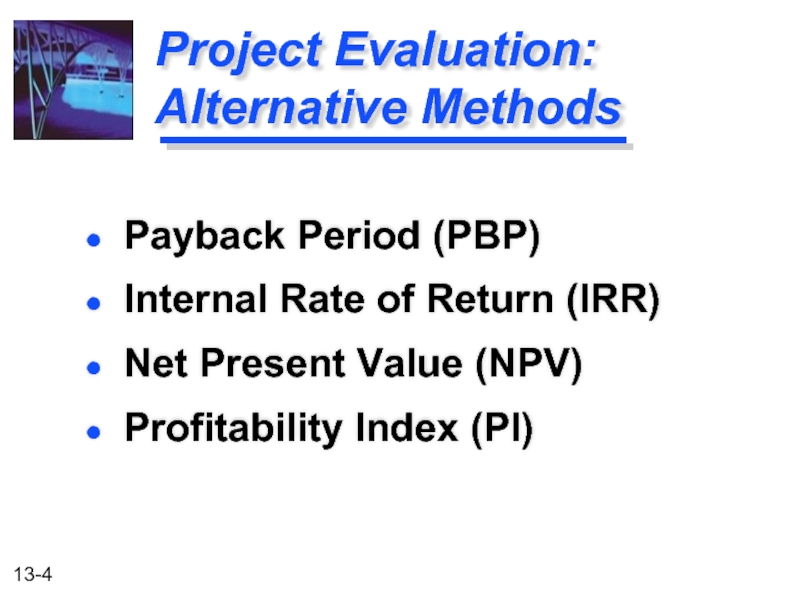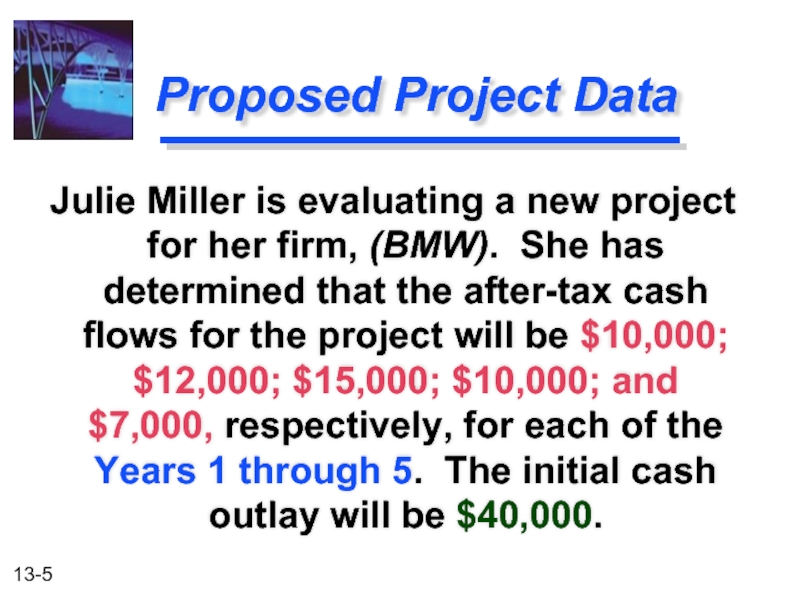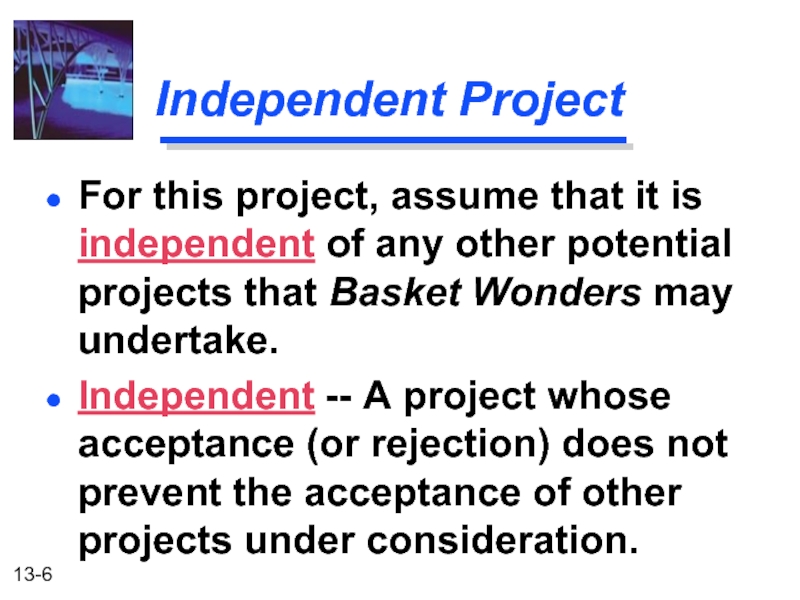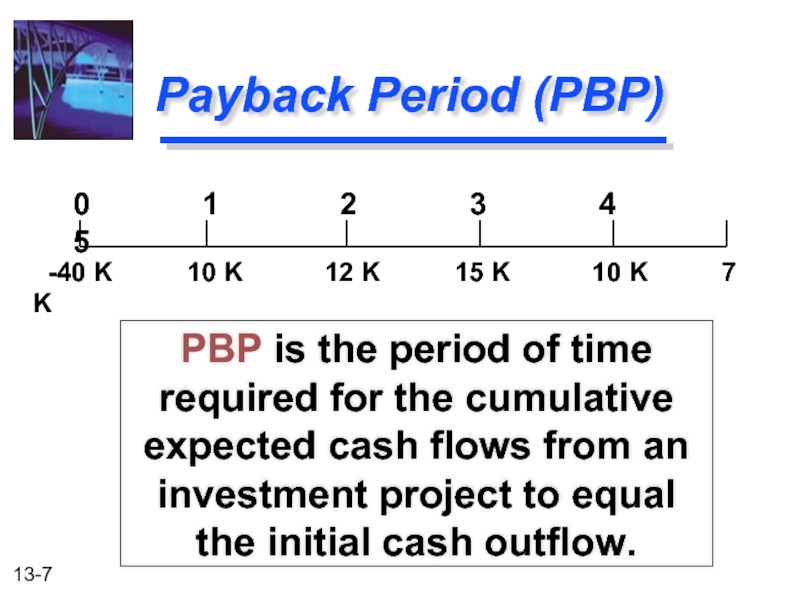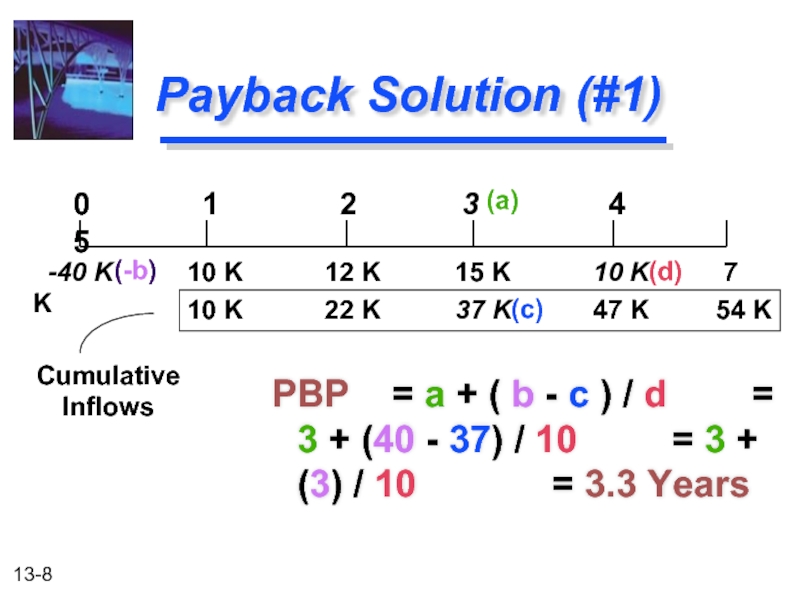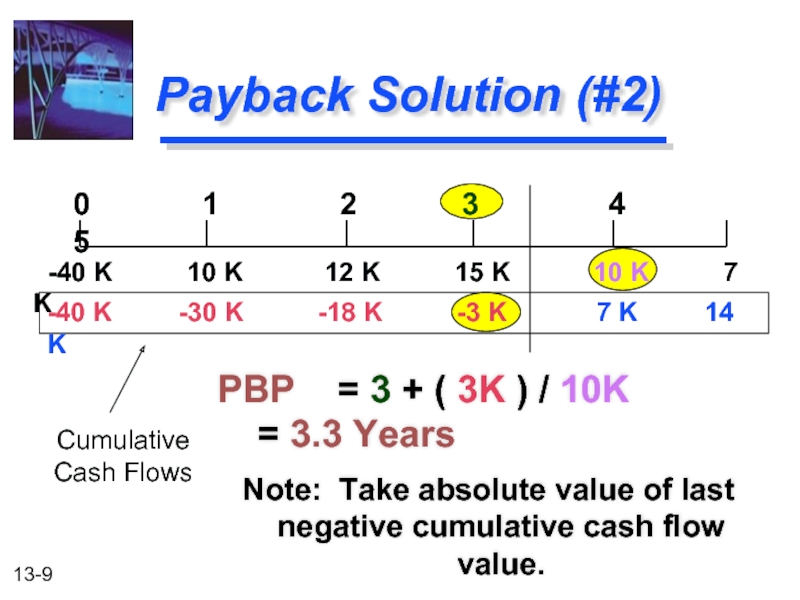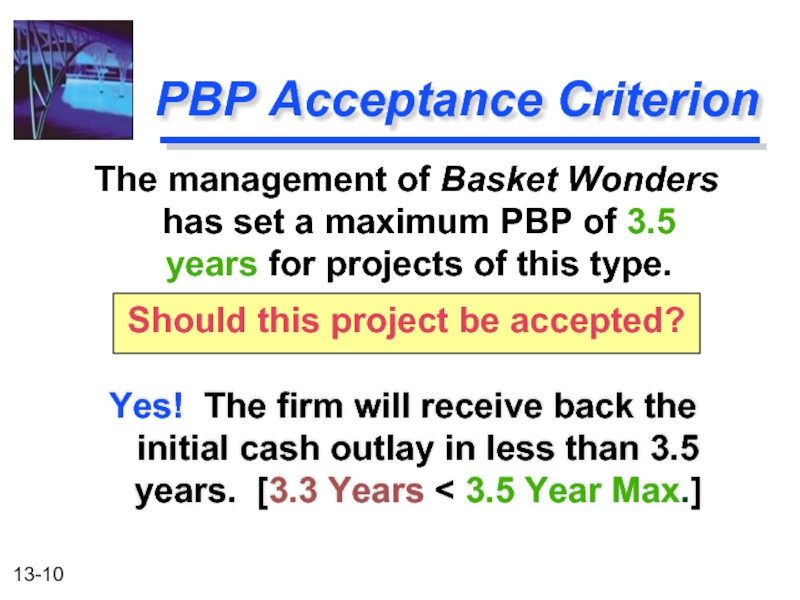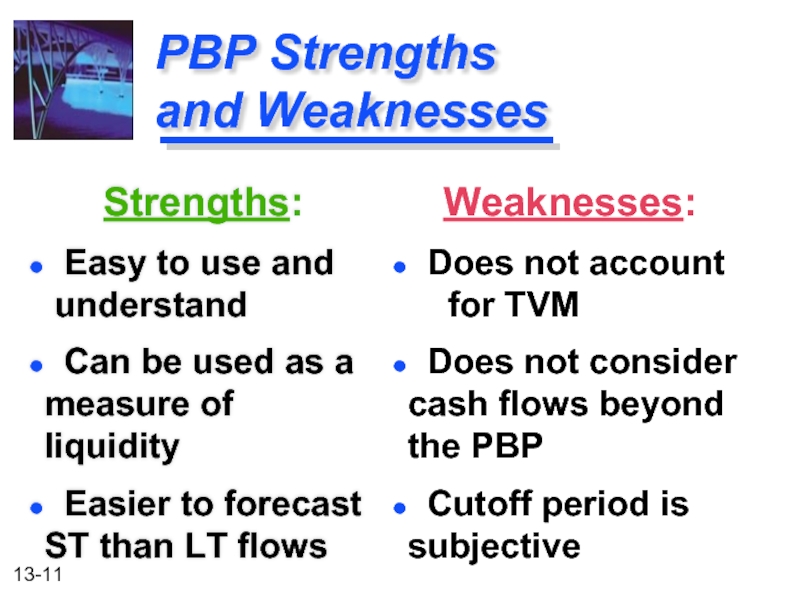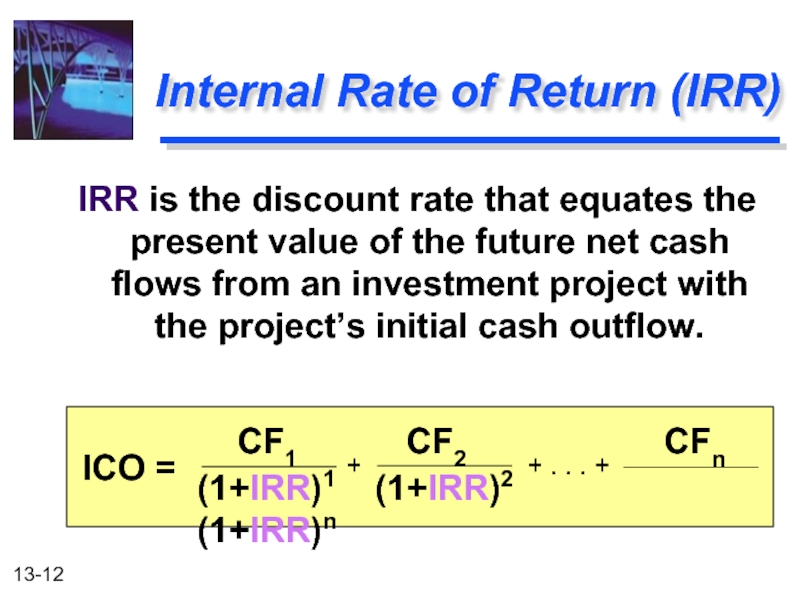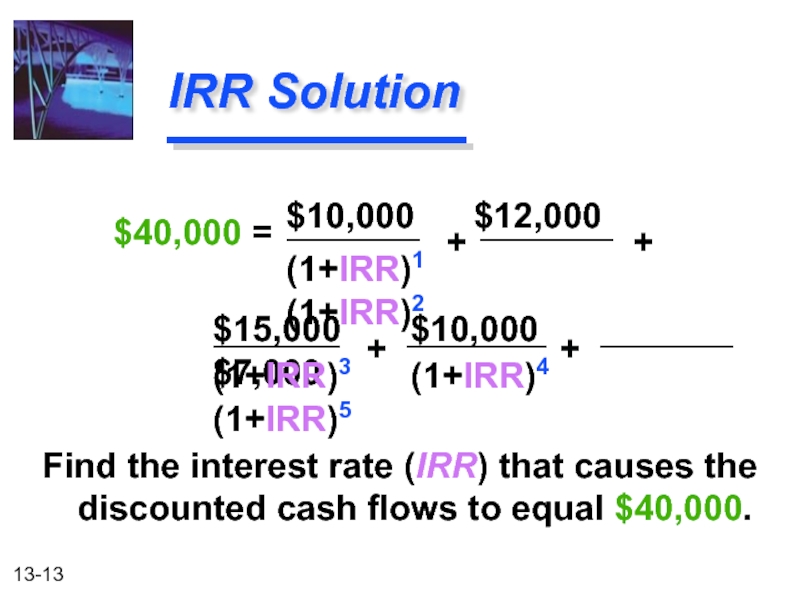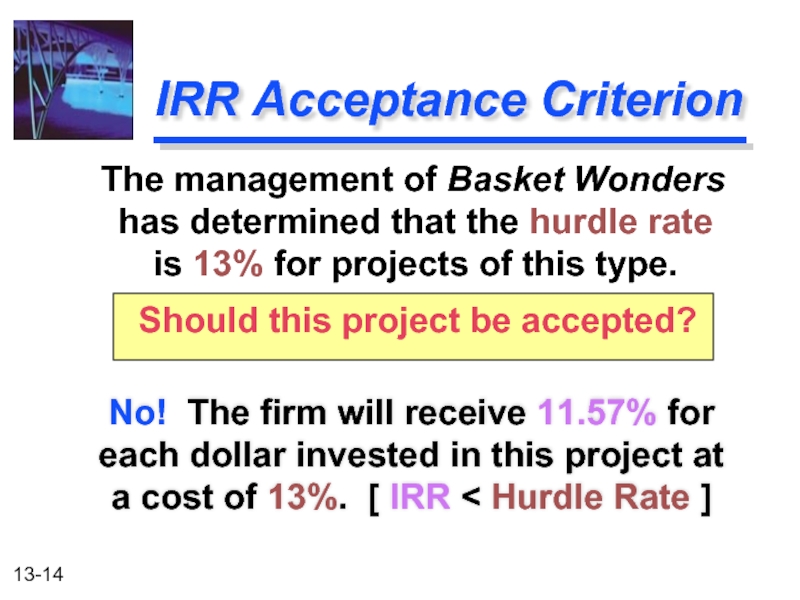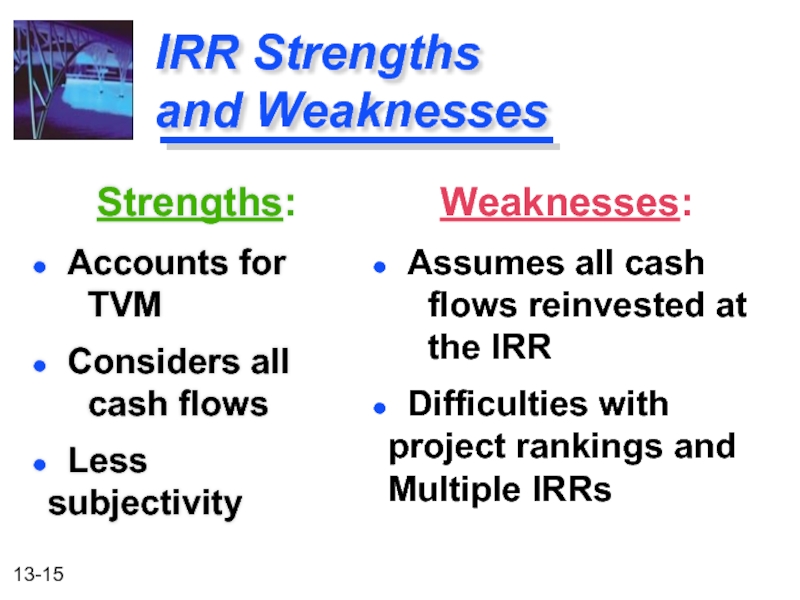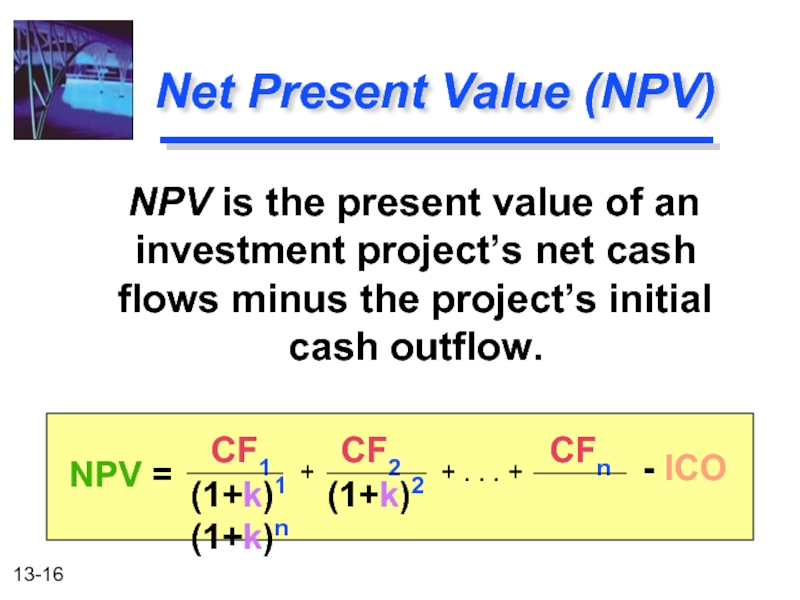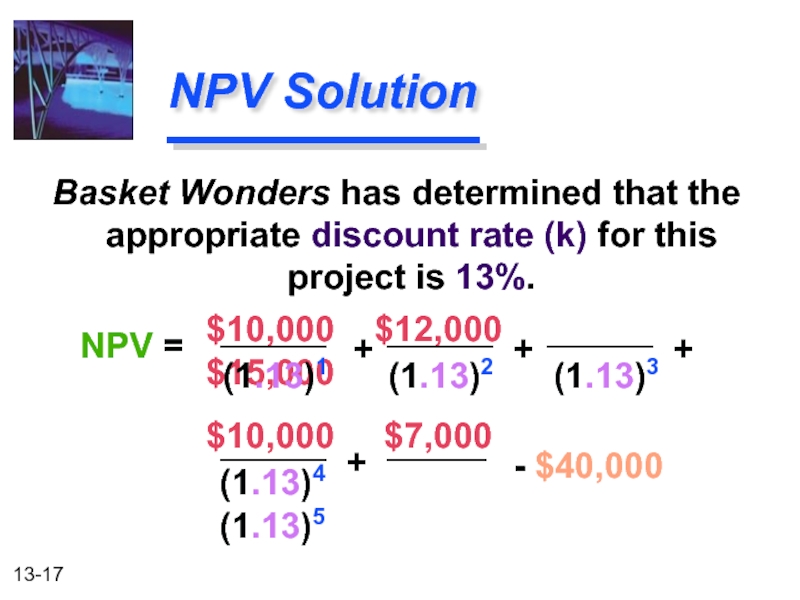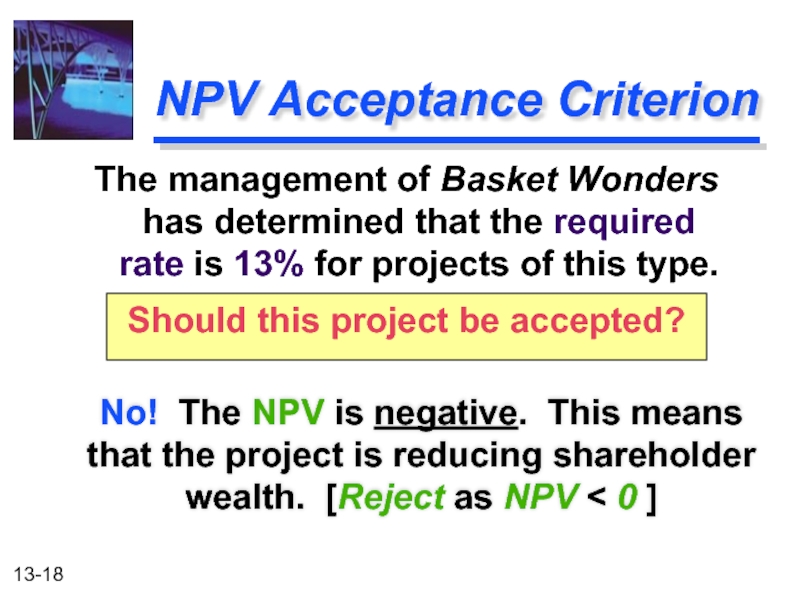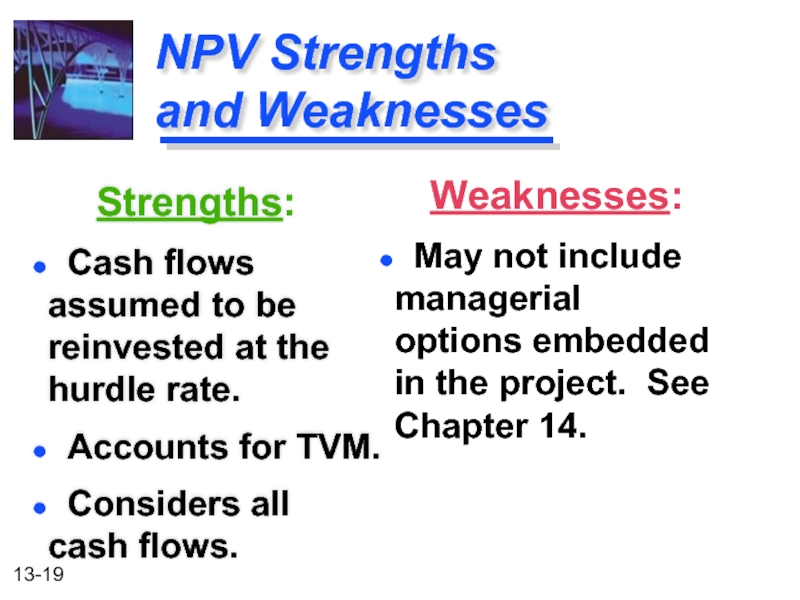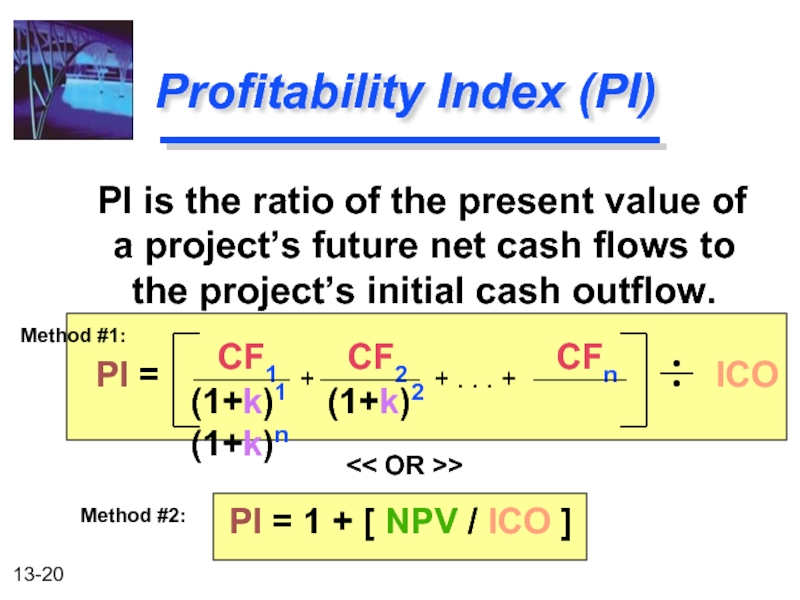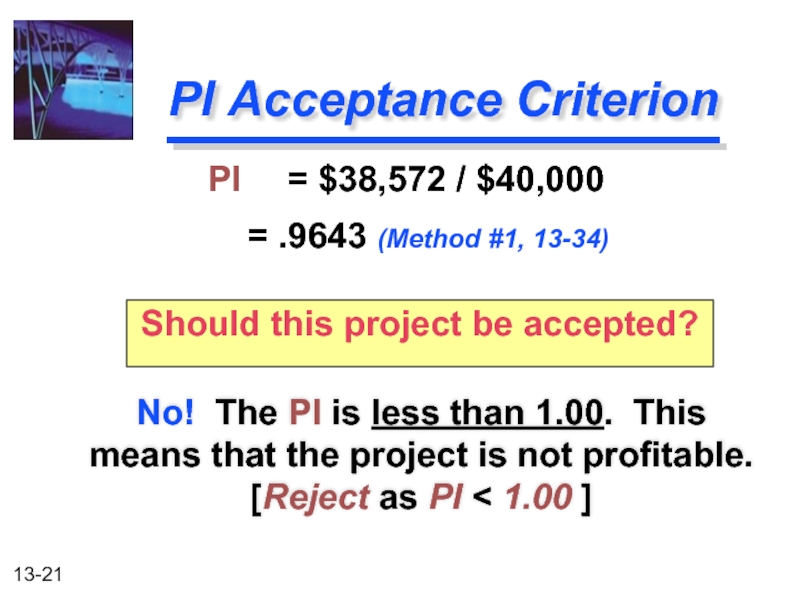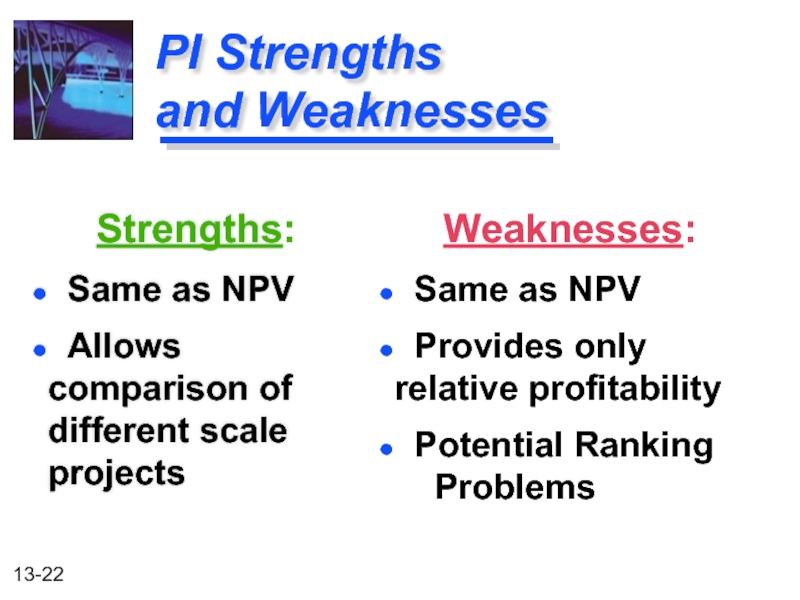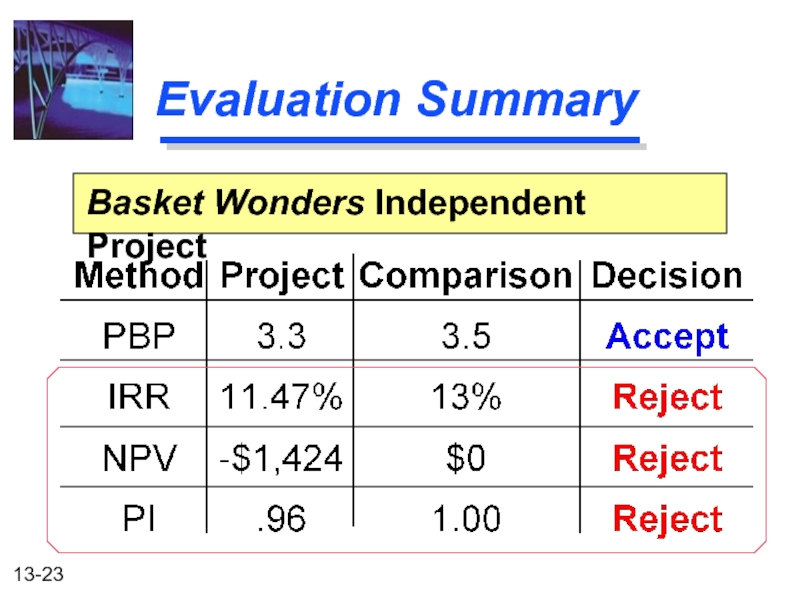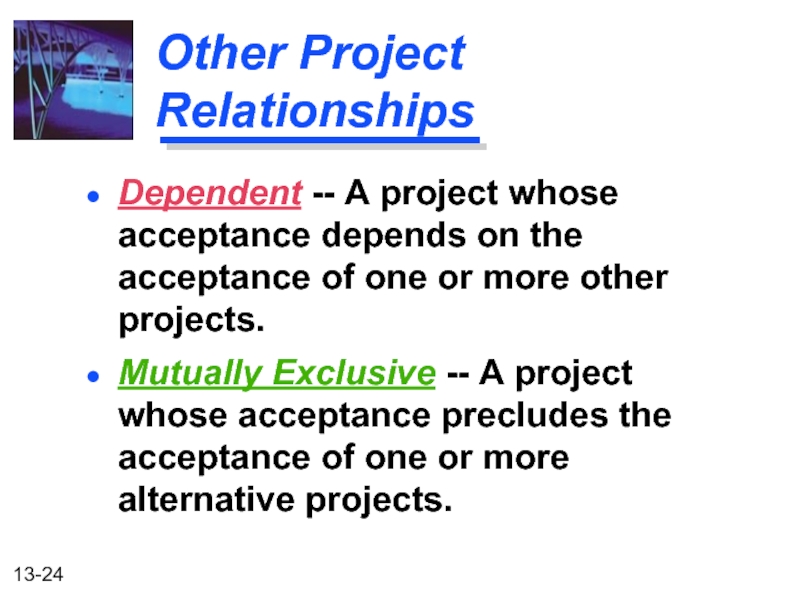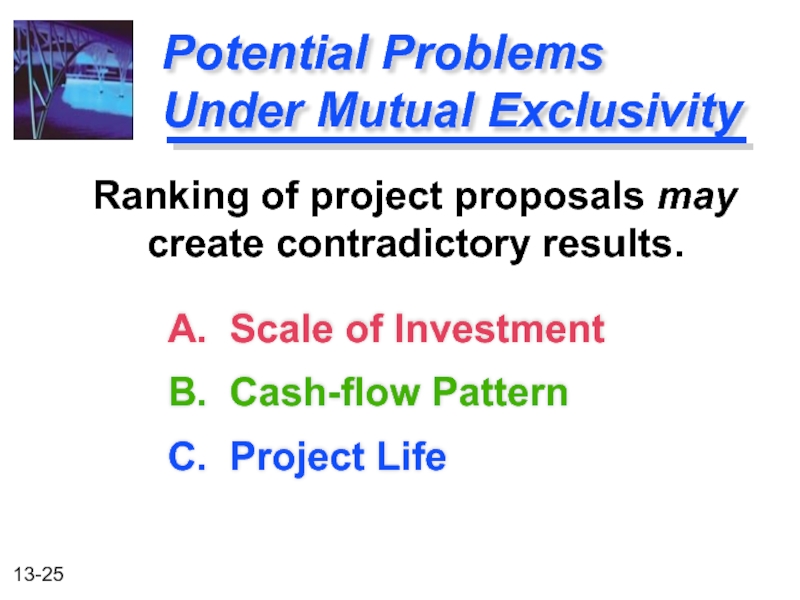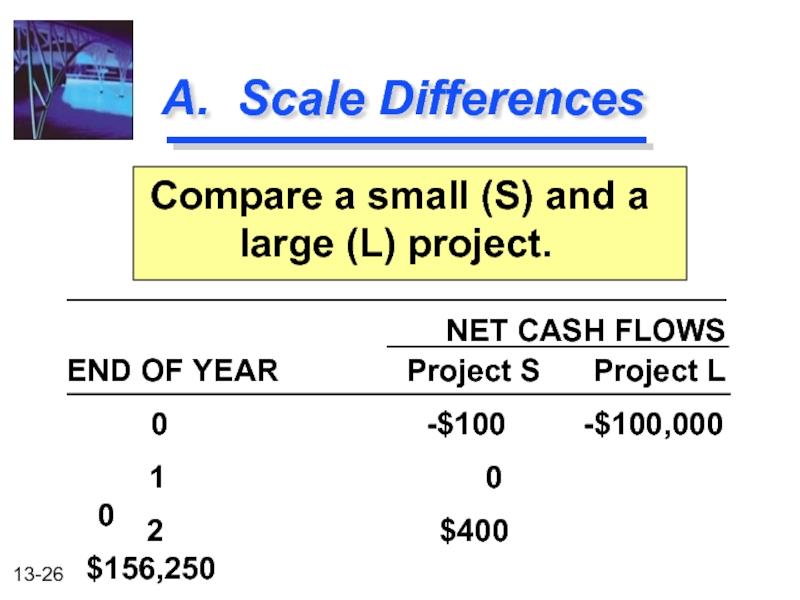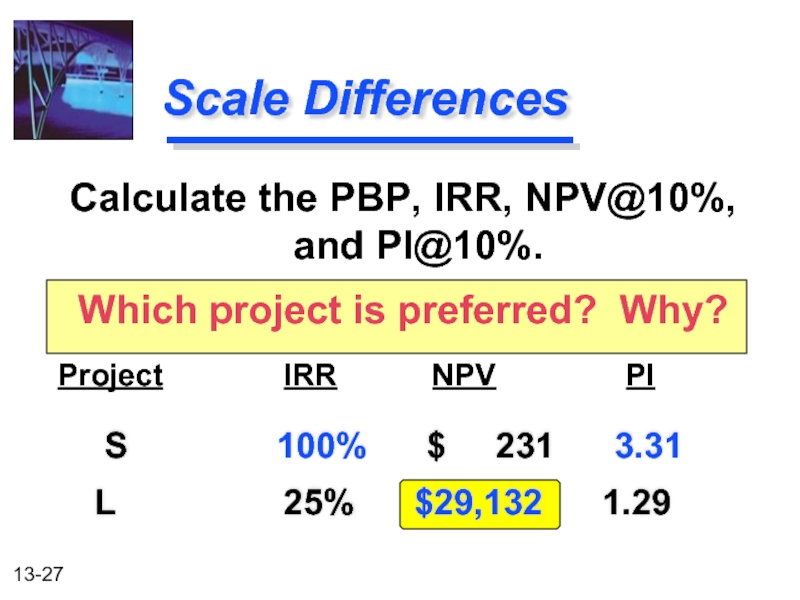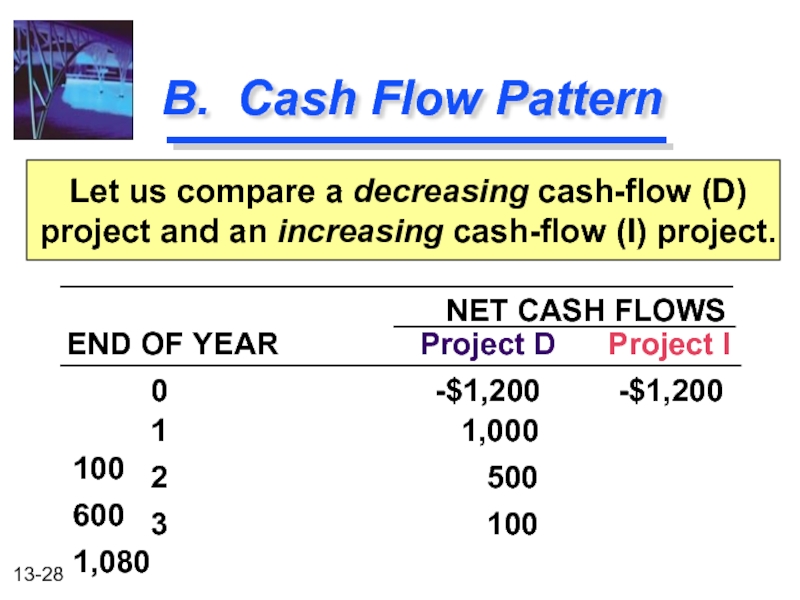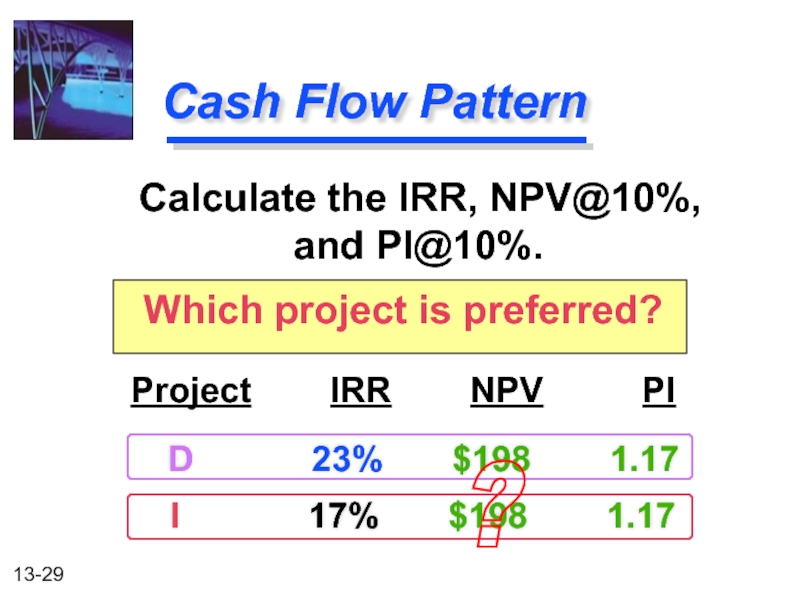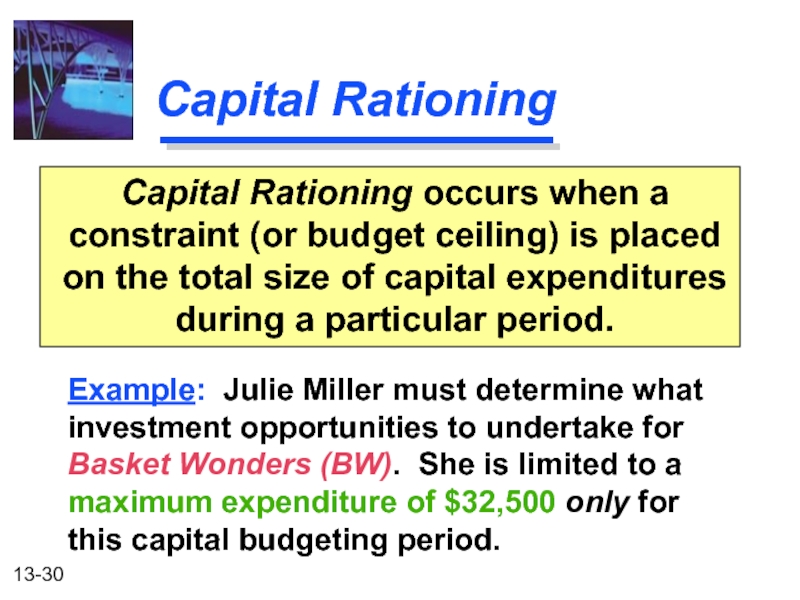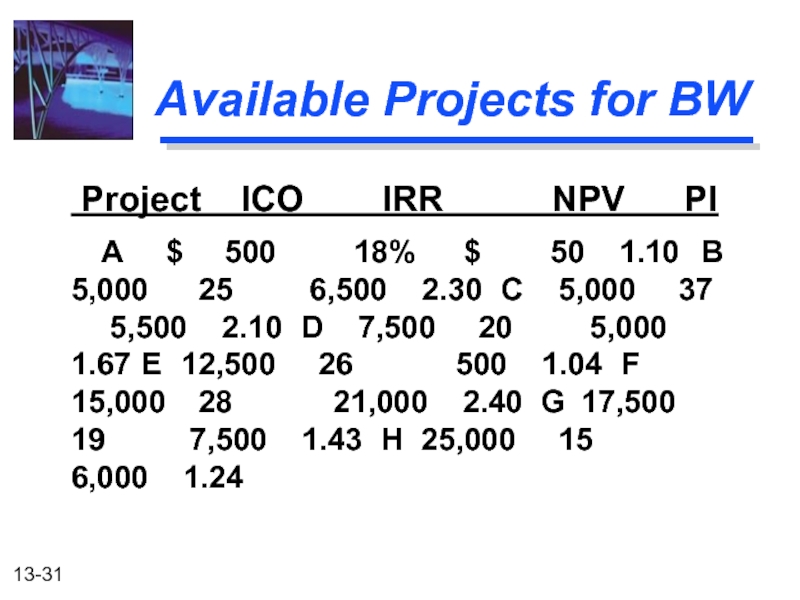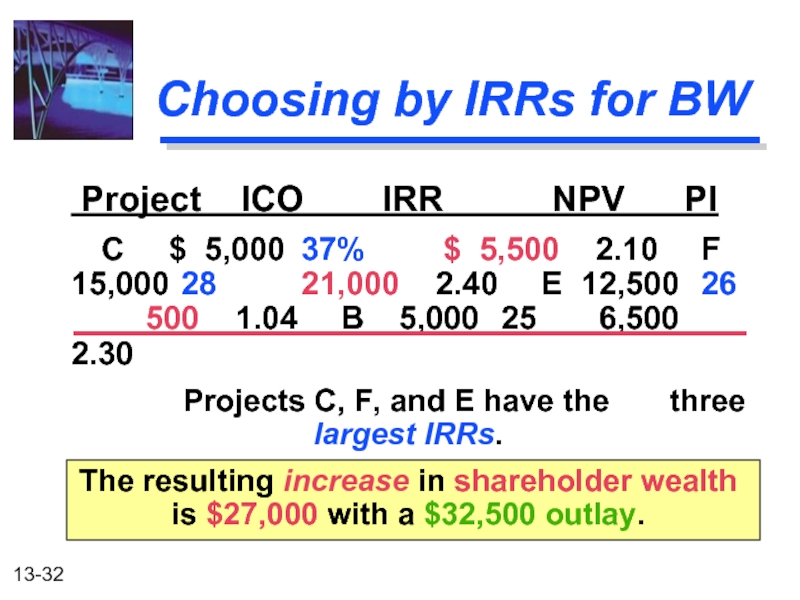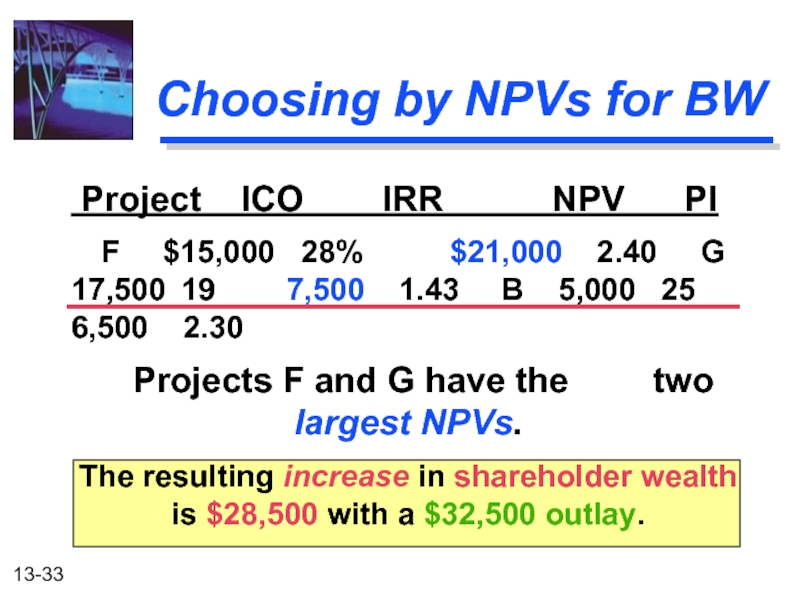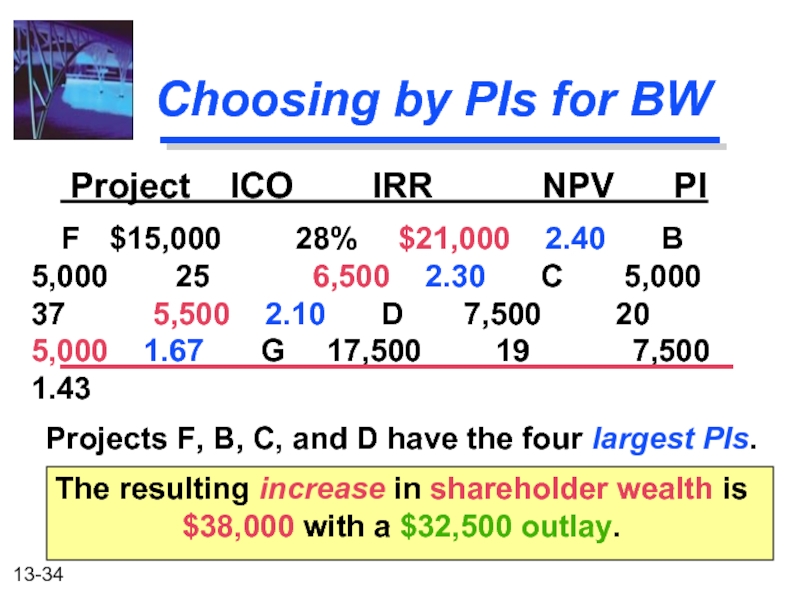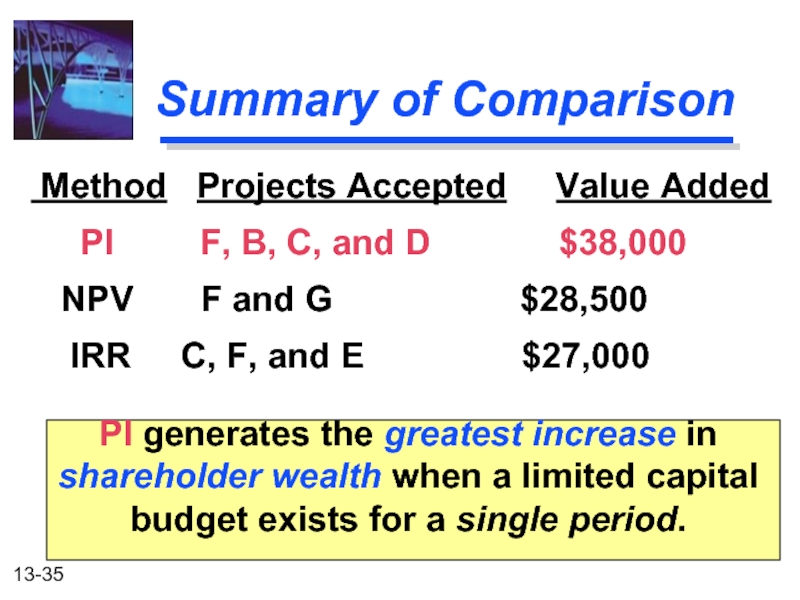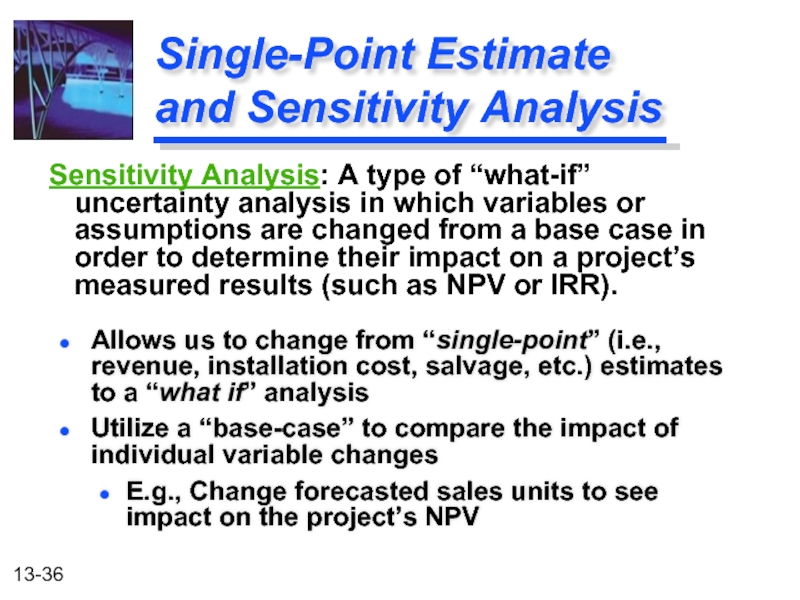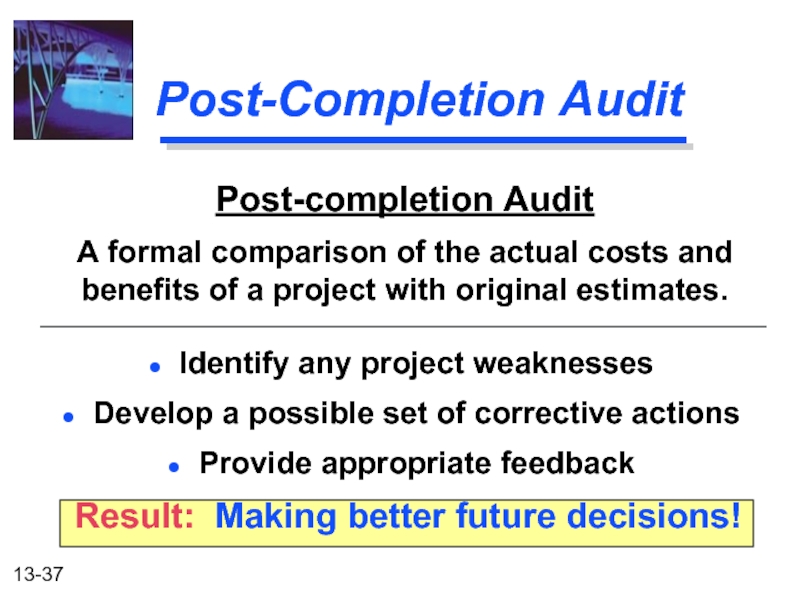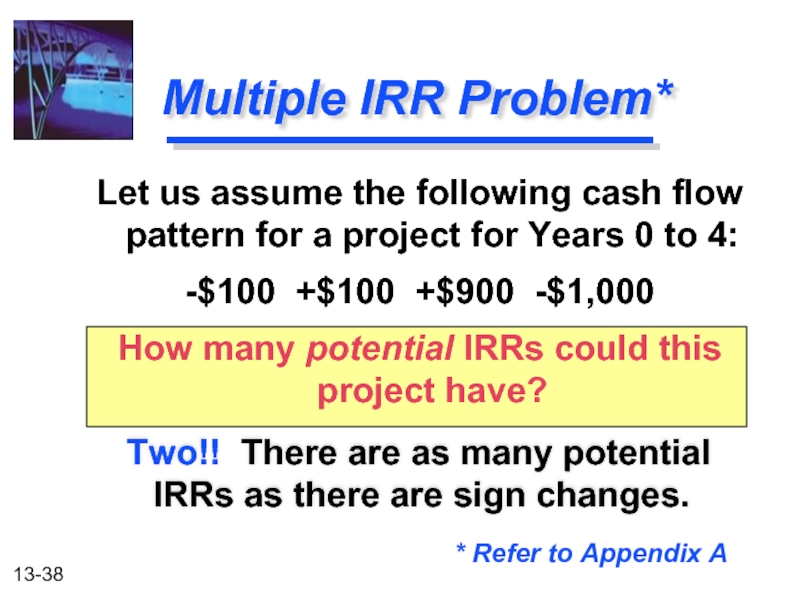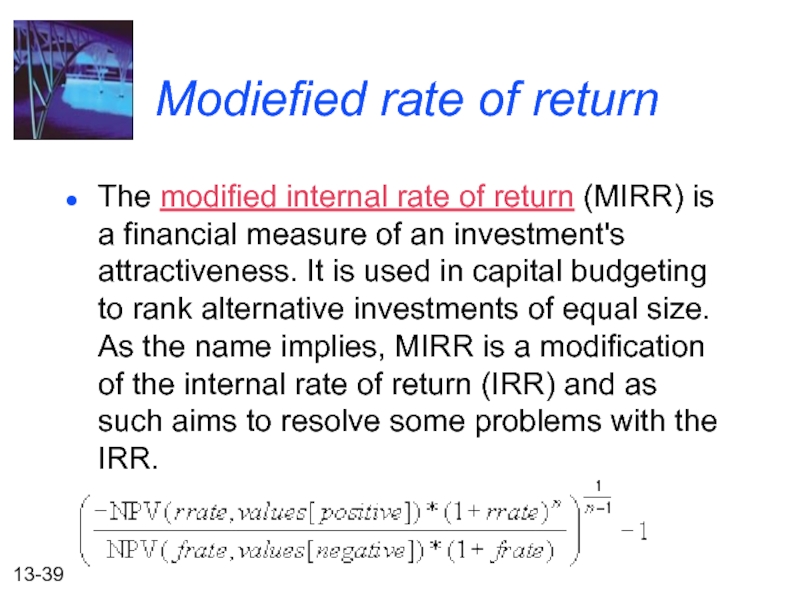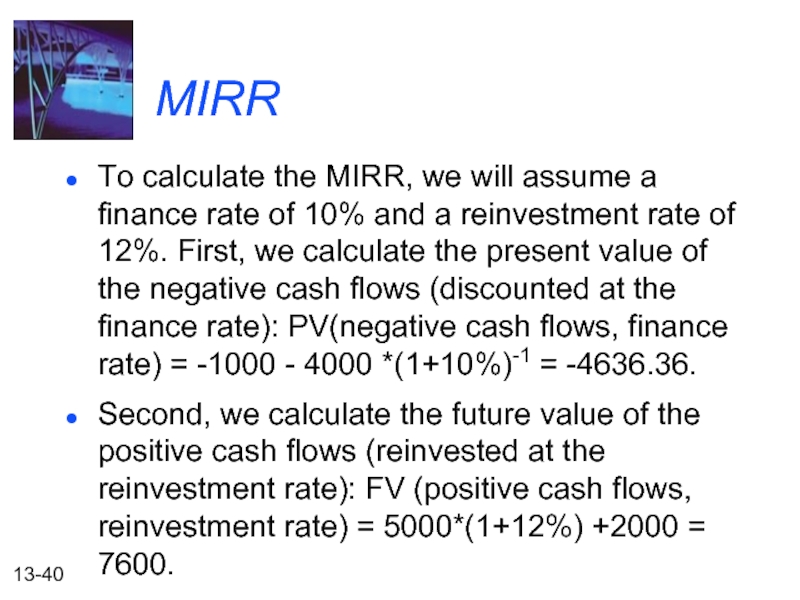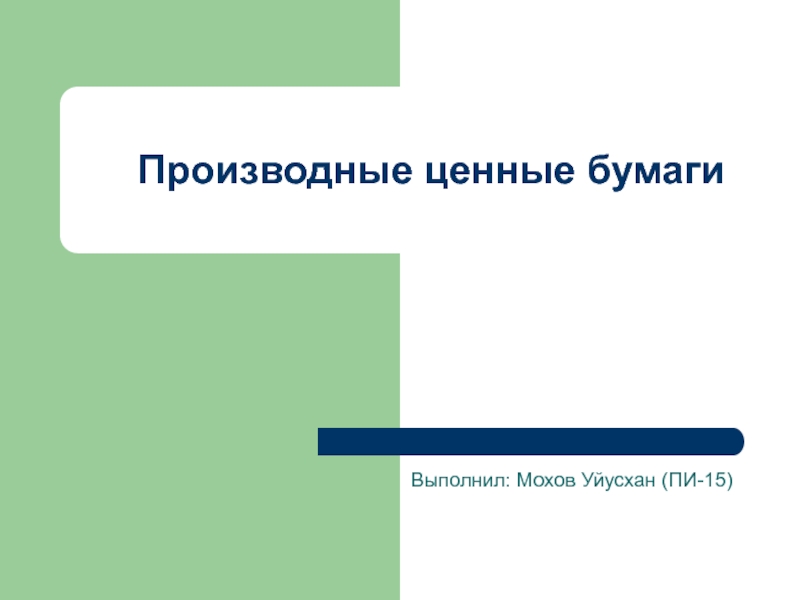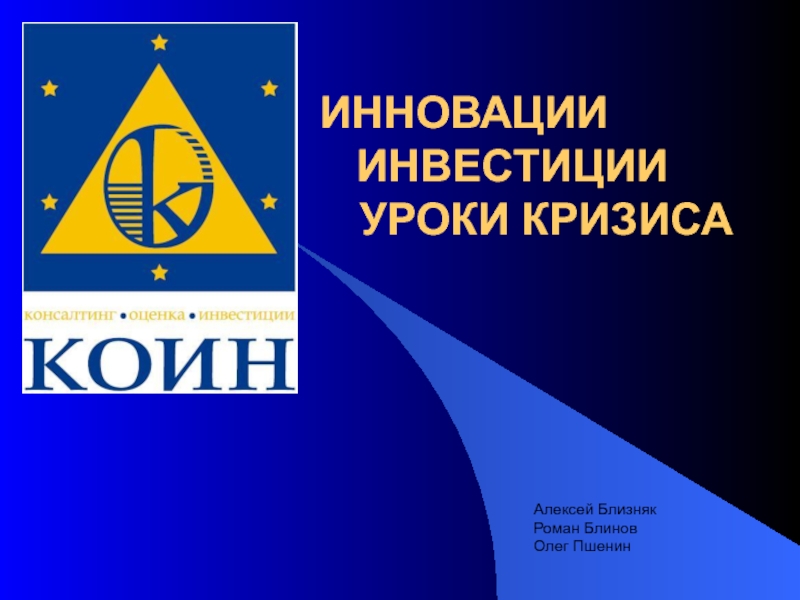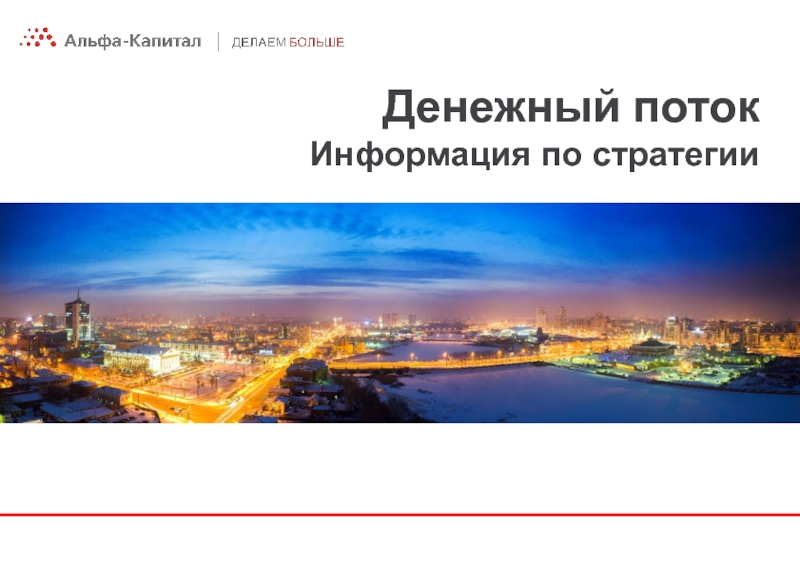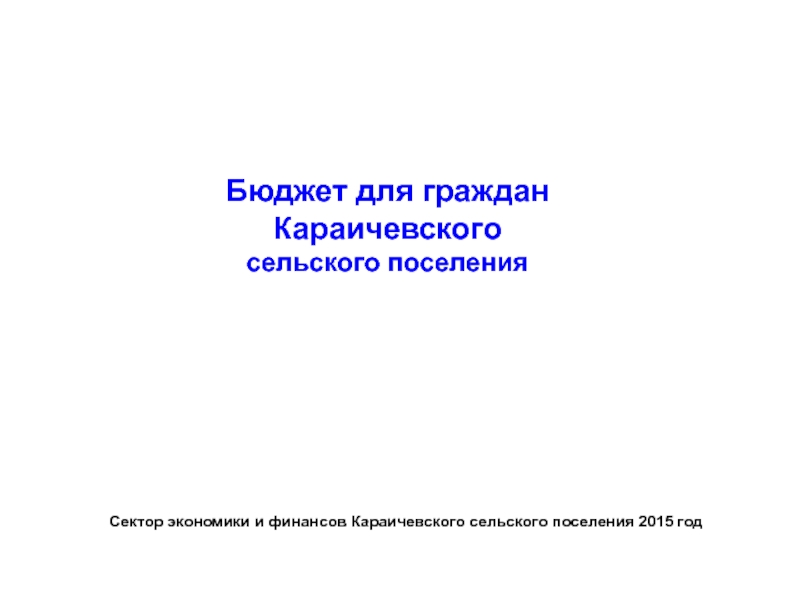- Главная
- Разное
- Дизайн
- Бизнес и предпринимательство
- Аналитика
- Образование
- Развлечения
- Красота и здоровье
- Финансы
- Государство
- Путешествия
- Спорт
- Недвижимость
- Армия
- Графика
- Культурология
- Еда и кулинария
- Лингвистика
- Английский язык
- Астрономия
- Алгебра
- Биология
- География
- Детские презентации
- Информатика
- История
- Литература
- Маркетинг
- Математика
- Медицина
- Менеджмент
- Музыка
- МХК
- Немецкий язык
- ОБЖ
- Обществознание
- Окружающий мир
- Педагогика
- Русский язык
- Технология
- Физика
- Философия
- Химия
- Шаблоны, картинки для презентаций
- Экология
- Экономика
- Юриспруденция
Capital Budgeting Techniques презентация
Содержание
- 1. Capital Budgeting Techniques
- 2. After studying Chapter 13, you should be
- 3. Capital Budgeting Techniques Project Evaluation and
- 4. Project Evaluation: Alternative Methods Payback Period
- 5. Proposed Project Data Julie Miller is evaluating
- 6. Independent Project Independent -- A project whose
- 7. Payback Period (PBP) PBP is the period
- 8. (c) 10 K
- 9. Payback Solution (#2) PBP
- 10. PBP Acceptance Criterion Yes! The firm
- 11. PBP Strengths and Weaknesses Strengths:
- 12. Internal Rate of Return (IRR) IRR
- 13. $15,000 $10,000
- 14. IRR Acceptance Criterion No!
- 15. IRR Strengths and Weaknesses
- 16. Net Present Value (NPV) NPV
- 17. Basket Wonders has determined that the appropriate
- 18. NPV Acceptance Criterion No!
- 19. NPV Strengths and Weaknesses
- 20. Profitability Index (PI) PI
- 21. PI Acceptance Criterion
- 22. PI Strengths and Weaknesses
- 23. Evaluation Summary Basket Wonders Independent Project
- 24. Other Project Relationships Mutually Exclusive -- A
- 25. Potential Problems Under Mutual Exclusivity A.
- 26. A. Scale Differences Compare
- 27. Scale Differences Calculate the PBP,
- 28. B. Cash Flow Pattern Let us
- 29. D
- 30. Capital Rationing Capital Rationing occurs when a
- 31. Available Projects for BW Project
- 32. Choosing by IRRs for BW
- 33. Choosing by NPVs for BW
- 34. Choosing by PIs for BW
- 35. Summary of Comparison Method
- 36. Single-Point Estimate and Sensitivity Analysis Allows us
- 37. Post-Completion Audit Post-completion Audit A formal
- 38. Multiple IRR Problem* Two!! There
- 39. Modiefied rate of return The modified internal rate
- 40. MIRR To calculate the MIRR, we will
Слайд 2After studying Chapter 13, you should be able to:
Understand the payback
Understand the three major discounted cash flow (DCF) methods of project evaluation and selection – internal rate of return (IRR), net present value (NPV), and profitability index (PI).
Explain the calculation, acceptance criterion, and advantages (over the PBP method) for each of the three major DCF methods.
Define, construct, and interpret a graph called an “NPV profile.”
Understand why ranking project proposals on the basis of IRR, NPV, and PI methods “may” lead to conflicts in ranking.
Describe the situations where ranking projects may be necessary and justify when to use either IRR, NPV, or PI rankings.
Understand how “sensitivity analysis” allows us to challenge the single-point input estimates used in traditional capital budgeting analysis.
Explain the role and process of project monitoring, including “progress reviews” and “post-completion audits.”
Слайд 3Capital Budgeting Techniques
Project Evaluation and Selection
Potential Difficulties
Capital Rationing
Post-Completion Audit
Слайд 4Project Evaluation: Alternative Methods
Payback Period (PBP)
Internal Rate of Return
Net Present Value (NPV)
Profitability Index (PI)
Слайд 5Proposed Project Data
Julie Miller is evaluating a new project for her
Слайд 6Independent Project
Independent -- A project whose acceptance (or rejection) does not
For this project, assume that it is independent of any other potential projects that Basket Wonders may undertake.
Слайд 7Payback Period (PBP)
PBP is the period of time required for the
0 1 2 3 4 5
-40 K 10 K 12 K 15 K 10 K 7 K
Слайд 8(c)
10 K 22 K
Payback Solution (#1)
PBP = a + ( b - c ) / d = 3 + (40 - 37) / 10 = 3 + (3) / 10 = 3.3 Years
0 1 2 3 4 5
-40 K 10 K 12 K 15 K 10 K 7 K
Cumulative
Inflows
(a)
(-b)
(d)
Слайд 9
Payback Solution (#2)
PBP = 3 + ( 3K ) / 10K =
Note: Take absolute value of last negative cumulative cash flow value.
Cumulative
Cash Flows
-40 K 10 K 12 K 15 K 10 K 7 K
0 1 2 3 4 5
-40 K -30 K -18 K -3 K 7 K 14 K
Слайд 10
PBP Acceptance Criterion
Yes! The firm will receive back the initial cash
The management of Basket Wonders has set a maximum PBP of 3.5 years for projects of this type.
Should this project be accepted?
Слайд 11PBP Strengths
and Weaknesses
Strengths:
Easy to use and
Can be used as a measure of liquidity
Easier to forecast ST than LT flows
Weaknesses:
Does not account for TVM
Does not consider cash flows beyond the PBP
Cutoff period is subjective
Слайд 12
Internal Rate of Return (IRR)
IRR is the discount rate that equates
CF1 CF2 CFn
(1+IRR)1 (1+IRR)2 (1+IRR)n
+ . . . +
+
ICO =
Слайд 13$15,000 $10,000 $7,000
IRR Solution
$10,000
(1+IRR)1 (1+IRR)2
Find the interest rate (IRR) that causes the discounted cash flows to equal $40,000.
+
+
+
+
$40,000 =
(1+IRR)3 (1+IRR)4 (1+IRR)5
Слайд 14
IRR Acceptance Criterion
No! The firm will receive 11.57% for
The management of Basket Wonders has determined that the hurdle rate is 13% for projects of this type.
Should this project be accepted?
Слайд 15IRR Strengths
and Weaknesses
Strengths:
Accounts
Considers all cash flows
Less subjectivity
Weaknesses:
Assumes all cash flows reinvested at the IRR
Difficulties with project rankings and Multiple IRRs
Слайд 16
Net Present Value (NPV)
NPV is the present value of an
CF1 CF2 CFn
(1+k)1 (1+k)2 (1+k)n
+ . . . +
+
- ICO
NPV =
Слайд 17Basket Wonders has determined that the appropriate discount rate (k) for
$10,000 $7,000
NPV Solution
$10,000 $12,000 $15,000
(1.13)1 (1.13)2 (1.13)3
+
+
+
- $40,000
(1.13)4 (1.13)5
NPV =
+
Слайд 18
NPV Acceptance Criterion
No! The NPV is negative. This means
The management of Basket Wonders has determined that the required rate is 13% for projects of this type.
Should this project be accepted?
Слайд 19NPV Strengths
and Weaknesses
Strengths:
Cash flows assumed
Accounts for TVM.
Considers all cash flows.
Weaknesses:
May not include managerial options embedded in the project. See Chapter 14.
Слайд 20
Profitability Index (PI)
PI is the ratio of the present value
CF1 CF2 CFn
(1+k)1 (1+k)2 (1+k)n
+ . . . +
+
ICO
PI =
PI = 1 + [ NPV / ICO ]
<< OR >>
Method #2:
Method #1:
Слайд 21
PI Acceptance Criterion
No! The PI is less
PI = $38,572 / $40,000
= .9643 (Method #1, 13-34)
Should this project be accepted?
Слайд 22PI Strengths
and Weaknesses
Strengths:
Same as NPV
Weaknesses:
Same as NPV
Provides only relative profitability
Potential Ranking Problems
Слайд 24Other Project Relationships
Mutually Exclusive -- A project whose acceptance precludes the
Dependent -- A project whose acceptance depends on the acceptance of one or more other projects.
Слайд 25Potential Problems
Under Mutual Exclusivity
A. Scale of Investment
B. Cash-flow Pattern
C. Project
Ranking of project proposals may create contradictory results.
Слайд 26
A. Scale Differences
Compare a small (S) and a large
NET CASH FLOWS
Project S Project L
END OF YEAR
0 -$100 -$100,000
1 0 0
2 $400 $156,250
Слайд 27
Scale Differences
Calculate the PBP, IRR, NPV@10%, and PI@10%.
Which project is preferred?
Project IRR NPV PI
S 100% $ 231 3.31
L 25% $29,132 1.29
Слайд 28
B. Cash Flow Pattern
Let us compare a decreasing cash-flow (D) project
NET CASH FLOWS
Project D Project I
END OF YEAR
0 -$1,200 -$1,200
1 1,000 100
2 500 600
3 100 1,080
Слайд 29
D 23%
I 17% $198 1.17
Cash Flow Pattern
Calculate the IRR, NPV@10%, and PI@10%.
Which project is preferred?
Project IRR NPV PI
?
Слайд 30Capital Rationing
Capital Rationing occurs when a constraint (or budget ceiling) is
Example: Julie Miller must determine what investment opportunities to undertake for Basket Wonders (BW). She is limited to a maximum expenditure of $32,500 only for this capital budgeting period.
Слайд 31Available Projects for BW
Project ICO IRR
A $ 500 18% $ 50 1.10 B 5,000 25 6,500 2.30 C 5,000 37 5,500 2.10 D 7,500 20 5,000 1.67 E 12,500 26 500 1.04 F 15,000 28 21,000 2.40 G 17,500 19 7,500 1.43 H 25,000 15 6,000 1.24
Слайд 32
Choosing by IRRs for BW
Project ICO
C $ 5,000 37% $ 5,500 2.10 F 15,000 28 21,000 2.40 E 12,500 26 500 1.04 B 5,000 25 6,500 2.30
Projects C, F, and E have the three largest IRRs.
The resulting increase in shareholder wealth is $27,000 with a $32,500 outlay.
Слайд 33
Choosing by NPVs for BW
Project ICO
F $15,000 28% $21,000 2.40 G 17,500 19 7,500 1.43 B 5,000 25 6,500 2.30
Projects F and G have the two largest NPVs.
The resulting increase in shareholder wealth is $28,500 with a $32,500 outlay.
Слайд 34
Choosing by PIs for BW
Project ICO
F $15,000 28% $21,000 2.40 B 5,000 25 6,500 2.30 C 5,000 37 5,500 2.10 D 7,500 20 5,000 1.67 G 17,500 19 7,500 1.43
Projects F, B, C, and D have the four largest PIs.
The resulting increase in shareholder wealth is $38,000 with a $32,500 outlay.
Слайд 35
Summary of Comparison
Method Projects Accepted Value Added
NPV F and G $28,500
IRR C, F, and E $27,000
PI generates the greatest increase in shareholder wealth when a limited capital budget exists for a single period.
Слайд 36Single-Point Estimate and Sensitivity Analysis
Allows us to change from “single-point” (i.e.,
Utilize a “base-case” to compare the impact of individual variable changes
E.g., Change forecasted sales units to see impact on the project’s NPV
Sensitivity Analysis: A type of “what-if” uncertainty analysis in which variables or assumptions are changed from a base case in order to determine their impact on a project’s measured results (such as NPV or IRR).
Слайд 37
Post-Completion Audit
Post-completion Audit
A formal comparison of the actual costs and benefits
Identify any project weaknesses
Develop a possible set of corrective actions
Provide appropriate feedback
Result: Making better future decisions!
Слайд 38
Multiple IRR Problem*
Two!! There are as many potential IRRs as
Let us assume the following cash flow pattern for a project for Years 0 to 4:
-$100 +$100 +$900 -$1,000
How many potential IRRs could this project have?
* Refer to Appendix A
Слайд 39Modiefied rate of return
The modified internal rate of return (MIRR) is a financial
Слайд 40MIRR
To calculate the MIRR, we will assume a finance rate of
Second, we calculate the future value of the positive cash flows (reinvested at the reinvestment rate): FV (positive cash flows, reinvestment rate) = 5000*(1+12%) +2000 = 7600.
